More than 4,000 species of saltwater fish are thought to inhabit the world’s coral reefs. Reefs occupy less than 1% of ocean surface area but provide the habitat for more than a quarter of all species. In the home, saltwater aquarium fish add color, flash, and personality to any tank. Selecting the best fish for your tank is a decision based on a couple of important factors:
- How new your tank is—fish suited for the living conditions of a newly set up marine aquarium are called starter fish. Suitable starter fish should be hardy, vibrant, and peaceful.
- Do you have coral? Many species nip at or even eat coral you would commonly keep in your aquarium. If you plan to keep corals with your fish, you will have to limit your choices to reef-safe fish.
- Compatibility with other species—As a general rule, most big fish will eat almost any smaller fish that will fit inside their mouth. But even similarly sized saltwater fish may not be compatible. Luckily you don’t have to guess. Check out the Saltwater Aquarium Blog Interactive Saltwater Fish Compatibility Chart to find out if the fish you are thinking about are compatible with each other.
Cycle your tank before adding saltwater aquarium fish
Everyone has their own opinion about what fish to add to a new saltwater aquarium. One of the biggest problems with new tanks is a phenomenon called New Tank Syndrome—essentially, new tanks are unstable, and oftentimes fish added to a new tank perish quickly—because the environment is too harsh. The most important thing you can do when setting up your new tank is to allow for the time to properly cycle the marine aquarium.
Cycling a marine aquarium is the process of establishing a biological filter. Adding your first fish (sometimes called starter fish) to a marine aquarium before the tank has completed cycling is one of the most common mistakes hobbyists make. The best way to cycle a marine aquarium is with the fishless cycling method.
Set up a quarantine tank to prevent the spread of parasites and disease

It may seem like a hassle to set up a quarantine tank, but it is probably the most important thing you can do to ensure the long-term health and success of the saltwater fish in your aquarium. Parasites like saltwater ich and marine velvet spread rapidly in a marine aquarium and can be a nightmare to treat in a reef tank. The best medicine is prevention. The best way to prevent the problem is by setting up a quarantine tank.
Acclimate before adding saltwater aquarium fish to your tank
From the moment the saltwater fish is put in the plastic bag for the trek home to your marine aquarium, the water inside that bag begins to degrade, and the temperature begins to change. Depending on the quality of the water when the fish was packed for transportation, and the time it takes for the fish to reach your home, the water parameters inside the bag (temperature, pH, ammonia concentration) may be significantly different from the water in your tank. Therefore, to avoid shocking (and potentially killing) your saltwater fish, you need to acclimate the fish to the new marine aquarium conditions. One of the most effective ways to acclimate new arrivals is with the drip method.
Proper feeding of saltwater aquarium fish
There are a few things you should consider when feeding your saltwater aquarium fish:
- It is better to feed your fish in small portions 2-3 times a day than feed a large portion once a day.
- Uneaten food will decay and deteriorate the water quality in your marine aquarium.
- Understand the nutritional requirements and feeding preferences for the fish species in your aquarium and try to meet those needs with a varied diet of high-quality foods
- Herbivorous fish like tangs and surgeonfish need seaweed in their diets
- Certain angelfish species require sponges and other reef-based foods and do better when feeding a varied diet
- Many butterflyfish species eat coral polyps and are nearly impossible to keep in a reef tank
- Fishes that are reluctant to eat in your aquarium can often be coaxed into eating with frozen foods (instead of dry flakes or pellets) or live foods like brine shrimp or black worms
Diseases of saltwater aquarium  fish
fish
Disease and parasitic infections are major reasons aquarists can become frustrated with and leave the saltwater aquarium hobby. Infestations of marine velvet or saltwater ich can ransack the fish in a marine aquarium. Once inside your tank, eliminating parasites can be a major hassle.
Common saltwater fish diseases/parasitic infections are:
- Saltwater ich—a parasitic infection that looks like tiny white dots that attach to the fins, scales, and gills
- Marine velvet—an infection caused by a single-celled parasite known as a dinoflagellate. Marine velvet looks like tiny specks of gold on the fins and scales of your fish. Affected fish will show signs of stress and rapid breathing. This is a severe and deadly parasite
- Brooklynella—a disease caused by a protozoan. One of the most obvious symptoms will be the excessive production of mucus on the skin of an infected fish.
- Black ich—is a worm infection that looks like tiny black dots. Surgeonfish and tangs are commonly affected by this disease.
- Fin rot—is the deterioration of the fins and is caused by bacteria. Fin rot is often made worse by poor water conditions and can be treated with water changes and antibiotics to kill the bacteria.
- Popeye—also caused by bacteria, popeye shows up as swelling or cloudiness of the eyes. Popeye can also be treated with an antibiotic.
- Head and lateral line erosion (HLLE)—is also called hole-in-the-head disease and appears as holes/sores on the head and lateral line of your piscine friend. HLLE appears to have both a viral and nutritional component that causes the condition. In addition, there is a link between HLLE and the use of activated carbon in the tank. Don’t miss this article. It is a MUST READ.
A great place to learn about what the different diseases look like is here.
If you are looking for a good book on the topic, check out Fish Disease Diagnosis and Treatment by Edward J. Noga. It provides a very nice overview of the common (and uncommon) diseases, parasites, and treatments.
Saltwater fish care guides
Are you looking for more information about a particular species of saltwater fish? Each species can have specific requirements for caring for them. Check out these species profile care guide pages for more information:
Groups of aquarium fish
- 20 Most Popular Saltwater Fish
- 21 Best Algae-eating saltwater fish
- 25 Best beginner fish
- 27 Types of Tang
- Best fish for a small saltwater tank
- 7 Coolest saltwater aquarium fish (that are also great for all experience levels)
- Fish you should avoid
- 7 Aggressive fish
- 6 Shy fish
- 7 Sly examples of saltwater fish mimicry
- Functional fishes
- Best starter fish
- 9 Fantastic types of tangs
- Most colorful saltwater fish
- Best clownfish tankmates
List of Saltwater Aquarium fish
If you are looking for specific care guide information or quick facts about a particular fish species, you can check out this List of saltwater fish for a link to the corresponding article.
Angelfish
- 25 Most Popular Types of Saltwater Angelfish
- French angelfish
- Majestic angelfish
- Flame angel
- Bicolor angel
- Coral beauty angelfish
- Best REEF SAFE Angelfish
Anthias
Assessors
Basslets
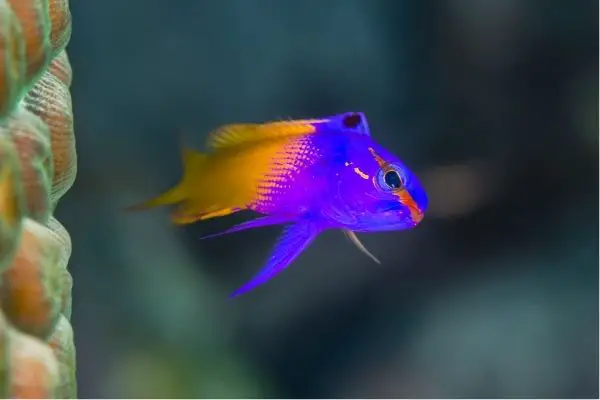
Blennies
Butterflyfish
Cardinalfish
Chromis
Clownfishes
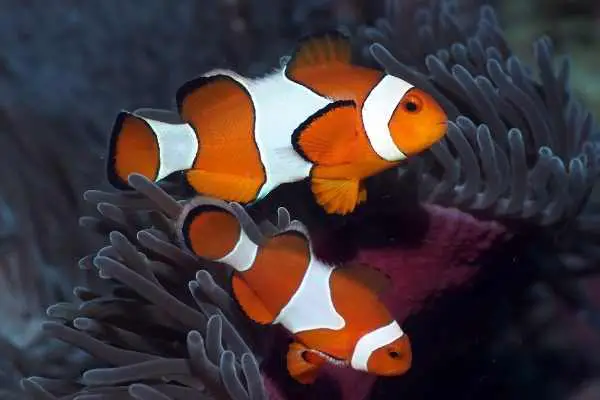
- Ocellaris clownfish
- Tomato clownfish
- Maroon clownfish
- Picasso clownfish
- Snowflake clownfish
- Clown fish care
Damselfishes
Dartfish
Dottybacks
Dragonets
Dwarf angelfish
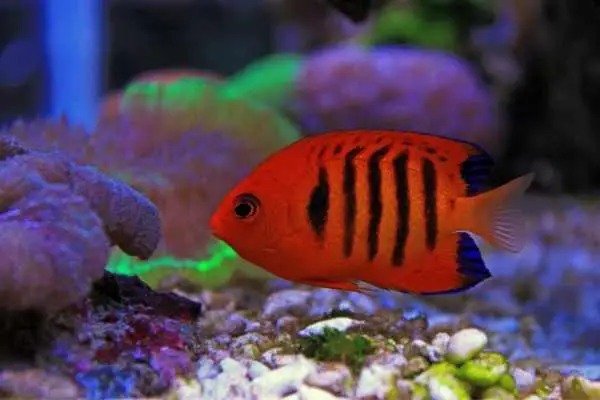
Eels
Filefish
Gobies

- Clown goby
- Diamond goby (sleeper goby)
- Engineer goby
- Neon Goby
- Firefish goby
- Mandarin goby
- Purple firefish goby
Groupers
Hawkfish
Jawfishes
Lionfish
Moorish Idol
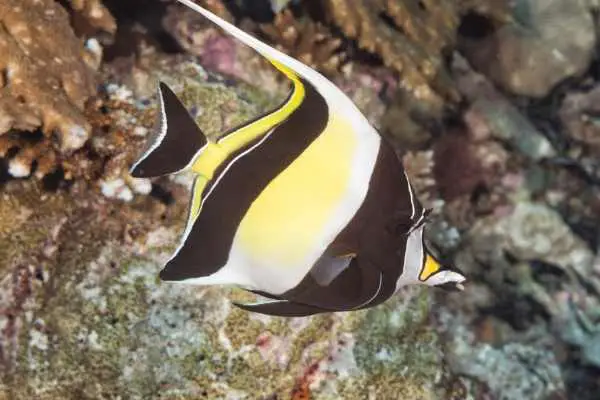
Pipefish
Pseudochromis
Pufferfish
Rabbitfishes
Squirrelfish
Tangs

- Blue hippo tang
- Clown Tang
- Doctorfish
- Gem tang
- Kole Tang
- Mimic Tang
- Orange shoulder tang
- Powder brown tang
- Purple tang
- Sailfin Tang
- Smallest tang fish
- Sohal tang
- Yellow tang
Triggerfish
Wrasses
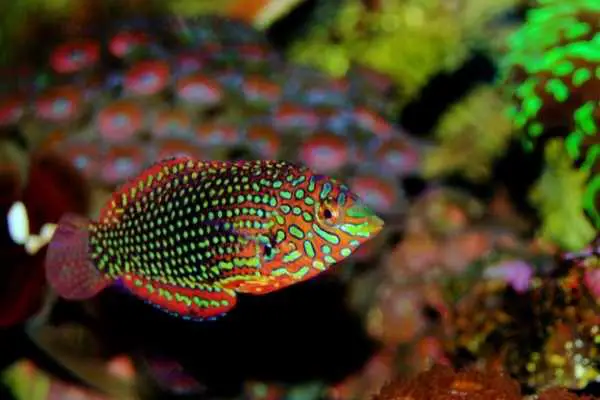
- Bluestreak cleaner wrasse
- Christmas wrasse
- Fairy wrasses
- Leopard wrasse
- Melanuras wrasse
- Red Coris wrasse
- Six line wrasse
- Yellow coris wrasse
How many saltwater aquarium fish per tank? Check out these stocking guides
If you know what size tank you want, or already have, and you are looking for some ideas about what the best fish are for that size tank, check out these super-helpful stocking guides:
- Best saltwater fish for a 10-gallon tank
- Best saltwater fish for a 20-gallon tank
- Best saltwater fish for a 30-gallon tank
- 40-gallon tank stocking guide
- 55-gallon tank dimensions and stocking
- 75-gallon tank: best fish and stocking levels
- Best saltwater fish for a 90-gallon tank
- Best fish for a 100-gallon saltwater tank
Breeding saltwater aquarium fish
Breeding saltwater fish is truly my passion. I have been fortunate enough to breed the Banggai Cardinalfish, Neon Goby, and Common Clownfish, but countless other species will readily breed in the marine aquarium.
It is important to have healthy, mature broodstock (the fish you want to be the parents) and feed them highly nutritious foods. It’s almost like you need to ‘fatten up your fish’ to get them ready to breed.
The three hardest parts about breeding are:
- Patience—the fish will breed in their own good time. Unfortunately, most of the fish commonly sold in fish stores and online are juvenile or young-adult fish—and it takes time for them to become mature enough to breed.
- Caring for the offspring—Freshwater fish emerge from their eggs as fry—fully formed, baby fish. On the other hand, most saltwater fish hatch from their eggs as larvae and require a fair amount of care and feeding even before they reach the stage of small fry, which requires much more care.
- Culture your own food–a lot of the art of breeding has to do with growing the right foods. First, you need to know the basics of culturing your own food, like phytoplankton, rotifers, copepods, and brine shrimp.
The best online sources for breeding information are MOFIB, the Marine Breeders Initiative, two forums of people dedicated to breeding.
- The best book you can buy about breeding is Matthew Wittenrich’s book, The Complete Illustrated Breeder’s Guide to Marine Aquarium Fishes.
Saltwater fish for sale online.
If you are looking for a reputable place to buy saltwater fish online, here are a few options to consider:
Other information about saltwater aquarium fish
Here are some other interesting articles about saltwater fish that you might enjoy:
- What are the most important water parameters?
- How many fish in an aquarium?
- Dealing with aggression
- Fish with legs. Are you serious?
- Aquarium industry statistics
- Saltwater fish care statistics
Please leave a comment.
What was the most helpful saltwater aquarium fish information linked to here? What questions do you have? Please leave a comment below.
Written by Albert B. Ulrich III. Please join the FREE Saltwater Aquarium Blog newsletter. I want to connect with you!



Leave a Reply